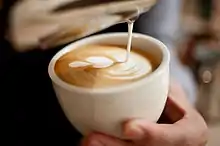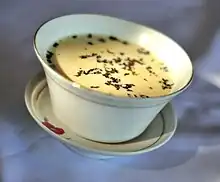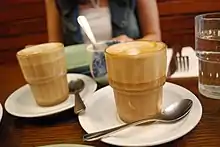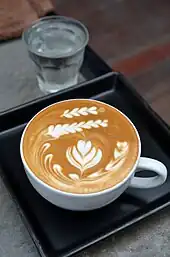 | |
| Type | Hot and iced beverage, milk coffee |
|---|---|
| Place of origin | Italy |
| Main ingredients | espresso, steamed milk |
| Variations | Caffè mocha (chocolate-flavored) |
Caffè latte (Italian: [kafˌfɛ lˈlatte][1][2]), often shortened to just latte (/ˈlɑːteɪ, ˈlæteɪ/)[3][4] in English, is a coffee drink of Italian origin made with espresso and steamed milk. Variants include the chocolate-flavored mocha or replacing the coffee with another beverage base such as masala chai (spiced Indian tea), mate, matcha, turmeric or rooibos; alternatives to milk, such as soy milk or almond milk, are also used.
The term comes from the Italian caffellatte[5] or caffè latte, from caffè e latte, literally "coffee and milk"; in English orthography either or both words sometimes have an accent on the final e (a hyperforeignism in the case of *latté, or to indicate it is pronounced, not the more-common silent final e of English). In northern Europe and Scandinavia, the term café au lait has traditionally been used for the combination of espresso and milk. In France, cafè latte is from the original name of the beverage (caffè latte); a combination of espresso and steamed milk equivalent to a "latte" is in French called un crème (un grand crème using cream instead of milk) and in German Milchkaffee.
Origin and history
Coffee, which was adopted from the Ottoman Empire, and milk have been part of European cuisine since the seventeenth century. Coffee was introduced to Europe by the Ottoman (Turkish) Empire during the invasion of Hungary in 1526. The Turks were also responsible for introducing coffee to Vienna, Austria in 1529.[6] Coffee was first mentioned in European texts in 1575 in the Aromatum et simplicium aliquot medica-mentorum apud Indos nascientum historia of Charles de l'Ecluse.[7] Caffè e latte, Milchkaffee, café au lait, and café con leche are domestic terms of traditional ways of drinking coffee, usually as part of breakfast in the home. Public cafés in Europe and the USA seem to have no mention of the terms until the twentieth century, although Kapuziner is mentioned in Austrian coffee houses in Vienna and Trieste in the second half of 1700s as "coffee with cream, spices, and sugar" (being the origin of the Italian cappuccino). Melange or café au lait was introduced in Austrian coffeehouses around 1850.
According to the Oxford English Dictionary, the term caffè e latte was first used in English in 1867 by William Dean Howells in his essay "Italian Journeys".[8] Kenneth Davids maintains that "...breakfast drinks of this kind have existed in Europe for generations, but the (commercial) caffè version of this drink is an American invention".[9] The French term café au lait was used in cafés in several countries in western continental Europe from 1900 onward, however, the term café crème was used in France for coffee with milk or cream.
The Austrian-Hungarian empire (Central Europe) had its own terminology for the coffees being served in coffee houses, while in German homes it was still called Milchkaffee. The Italians used the term caffè latte domestically, but it is not known from cafés such as Florian in Venice or any other coffee houses or places where coffee was served publicly. Even when the Italian espresso bar culture bloomed in the years after WWII both in Italy, and in cities such as Vienna and London, espresso and cappuccino are the terms used and latte is missing on coffee menus of that time.
In Italian, latte (pronounced [ˈlatte]) means "milk"—so ordering a "latte" in Italy will get the customer a glass of milk.[10][11]
In Spanish, the phrase café con leche (coffee with milk) is used, which is by default served in a medium or large cup whereas the similar cortado (coffee with less milk) is served in a small cup.
In English-speaking countries, latte is shorthand for caffelatte or caffellatte (from caffè e latte, "coffee and milk"), which is similar to the French café au lait, the Spanish café con leche, the Catalan cafè amb llet, or the Portuguese galão.
The Caffe Mediterraneum in Berkeley, California claims that one of its early owners, Lino Meiorin, "invented" and "made the latte a standard drink" in the 1950s. The latte was popularized in Seattle, Washington in the early 1980s [12] and spread more widely in the early 1990s.[13][14]
In northern Europe and Scandinavia, a similar "trend" started in the early 1980s as café au lait became popular again, prepared with espresso and steamed milk. Caffè latte started replacing this term around 1996–97 but both names often exist side by side and generally are more similar than different in preparation.
Current use
In Italy, latte is usually referred as Cappuccino, while caffelatte refers to a mix of coffee and non-steamed milk. Caffelatte is almost always prepared at home, for breakfast only. This coffee beverage is brewed with a stovetop moka pot and poured into a cup containing heated milk. Unlike the "international" latte drink, the milk in the Italian caffelatte is generally not foamed; and sugar is generally not added (although this can vary by drinker).
Outside Italy, typically a caffè latte is prepared in a 240 mL (8 US fl oz) glass or cup with one standard shot of espresso (either single, 30 mL or 1 US fl oz, or double, 60 mL or 2 US fl oz) and filled with steamed milk, with a layer of foamed milk approximately 12 mm (1⁄2 in) thick on the top. In the USA, a latte is often heavily sweetened with 3% sugar (or even more).[15] When wanting to order this beverage in Italy, one should ask for a latte macchiato.

The beverage is related to a cappuccino, the difference being that a cappuccino consists of espresso and steamed milk with a 20-millimetre-thick (0.79 in) layer of milk foam. A variant found in Australia and New Zealand that is similar to the latte is the flat white which is served in a smaller ceramic cup with warmed milk (without the layer of foam). In the United States this beverage is sometimes referred to as a wet cappuccino.
Iced latte
In the United States, an iced latte is usually espresso and chilled milk poured over ice.[16] Unlike a hot latte, it does not usually contain steamed milk or foam.[17] Iced lattes often have sugar or flavoring syrups added, although purists prefer them to consist simply of coffee and milk; they also are served blended with ice.[18] The espresso can be pre-chilled (sometimes as a mixture of espresso and milk) or frozen in advance to avoid warming up the drink.[19]
Serving styles

- In some establishments, lattes are served in a glass on a saucer with a napkin to hold the (sometimes hot) glass.
- Sometimes a latte is served in a bowl; in Europe, particularly Scandinavia, this is referred to as a café au lait.
- Increasingly common in the United States and Europe, latte art has led to the stylization of coffee making, and the creation of which is now a popular art form. Created by pouring steaming, and mostly frothed, milk into the coffee, that liquid is introduced into the beverage in such a way that patterns are distinguishable on the top of coffee. Popular patterns can include hearts, flowers, trees, and other forms of simplistic representations of images and objects.
- Often iced latte is served unstirred, so that coffee appears to "float" on top of white milk in a glass cup.
- A Layered Latte reverses the traditional order of creating a Latte. Rather than pouring steamed milk into a shot of espresso, pouring hot espresso into a glass of steamed milk will create a combination of temperature and density that will cause the latte to split into multiple density layers. The science behind the Layered Latte is referred to as double-diffusive convection. To make the Layered Latte, pour a shot of espresso into a glass of steamed milk at the same temperature. The layering of the beverage is largely dependent on variables such as glass size as well as the ratio between milk and espresso.[20][21]
- A variation of the iced latte, known as the "bootleg latte", "ghetto latte", or "poor man's latte",[22] is an iced espresso ordered in a larger than normal cup that will be filled up with free milk from the condiment station.[23] The beverage has spawned debate at coffee shops where an iced espresso is considerably cheaper than an iced latte.[24][25][26]
- In South Asia, East Asia, and North America, local variants of teas have been combined with steamed or frothed milk to create "tea latte". Coffee and tea shops now offer hot or iced latte versions of masala chai, matcha, and Royal Milk Tea. An Earl Grey latte is known as a "London fog".
- Other flavorings may be added to the latte to suit the taste of the drinker. Vanilla, chocolate, and caramel are all popular variants.
- In South Africa a red latte is made with rooibos tea and has been known as a caffeine-free alternative to traditional tea or coffee-based latte.
- An alternative version of latte may be prepared with soy milk or oat milk, as both have the ability to foam in the same way as cow milk, with soy milk versions being more prevalent. Such alternatives are popular among people with lactose intolerance and vegans.
- The Sea Salt Latte, a famous variation of the traditional style latte made with a salted milk foam over an espresso-based coffee, was invented and popularized by Taiwanese international cafe chain 85C Bakery Cafe.[27][28]

Politics
Calling people "latte drinkers" pejoratively has become a common political attack in some Western cultures. The popularity of espresso drinking in large cities, especially among more affluent urban populations, has caused some to consider it elitist behavior. In the United States, conservative political commentators have been known to call their opponents "latte-drinking liberal elites".[29][30][31][32] In Canadian politics, latte drinking is used to portray people as out-of-touch intellectuals and the antithesis of the Tim Hortons coffee drinker who is considered representative of an ordinary Canadian.[33][34]
According to a 2018 study, 16% of liberals in the United States prefer lattes, whereas 9% of conservatives and 11% of moderates do.[35] The study states further that the overwhelming majority of people, whether they are liberal, conservative, or moderate, express a preference for regular brewed coffee.[35]
See also
References
- ↑ "Caffè". Dizionario d'ortografia e di pronunzia. Archived from the original on 2022-01-05. Retrieved 2022-01-05.
- ↑ "Caffè". dipionline.it. Archived from the original on 2022-01-05. Retrieved 2022-01-05.
- ↑ "Latte – Definition of latte by Merriam-Webster". merriam-webster.com. Archived from the original on 2015-09-20. Retrieved 2008-03-17.
- ↑ "latte – definition of latte in English from the Oxford dictionary". oxforddictionaries.com. Archived from the original on September 21, 2020.
- ↑ "caffellatte in Vocabolario". Treccani. Archived from the original on 2019-07-12. Retrieved 2019-07-12.
- ↑ William J. Duiker; Jackson J. Spielvogel (2014). World History. Routledge. pp. 189–190. ISBN 9781317895701.
- ↑ Cowan, Brian (1 October 2008). The Social Life of Coffee: The Emergence of the British Coffeehouse. Yale University Press. pp. 16, 188, 223. ISBN 978-0-300-13350-9.
- ↑ "Latte". Oxford English Dictionary (new online ed.). Oxford University Press. Retrieved 2011-11-22.
- ↑ Davids, Kenneth (2001-05-04). Coffee: A Guide to Buying, Brewing, and Enjoying, Fifth Edition. St. Martin's Press. pp. 153–. ISBN 978-0-312-24665-5. Retrieved 18 January 2014.
- ↑ Schomer, David (1996). Espresso coffee (second ed.). p. 151. ISBN 1-59404-031-1..
- ↑ "Coffee traditions in Italy". Ms adventures in Italy. 2007-07-11. Archived from the original on 2011-11-30. Retrieved 2011-11-22.
- ↑ "Steamed milk nothing new for coffee drinkers". Ocala Star-Banner. Jan 4, 1995. Archived from the original on March 19, 2022. Retrieved August 28, 2020..
- ↑ "Americans wake up and smell the coffee". New York Times. 1992-09-02. Archived from the original on 2016-03-05. Retrieved 2017-02-17.
... espresso-based drinks with names like caffe latte ...
. - ↑ Brown, Nick (2016-12-12). "Remembering Latte Birthplace and Quintessential Counterculture Destination Caffe Med". Daily Coffee News. Archived from the original on 2018-09-12. Retrieved 2018-09-12.
- ↑ "Caffè Latte". starbucks.com. Archived from the original on 2016-08-14. Retrieved 2016-08-07.
- ↑ "Iced Caffè Latte". Starbucks.com. Archived from the original on 19 May 2014. Retrieved 19 May 2014.
- ↑ Johns, Sherri (2005). Coffee Cafe. New Holland Publishers. ISBN 978-1-84537-037-4.
- ↑ Laskin, Avner (2009). Coffee: More Than 65 Delicious & Healthy Recipes. Sterling Publishing Company, Inc. p. 46. ISBN 978-1-4027-4937-7.
- ↑ Moore, Victoria (Apr 22, 2010). How to Drink. Andrews McMeel Publishing. pp. 144–145. ISBN 978-0-7407-9845-0.
- ↑ Klein, Joanna (2017-12-12). "How Layers in a Latte Form". The New York Times. ISSN 0362-4331. Archived from the original on 2022-12-02. Retrieved 2022-12-02.
- ↑ Xue, Nan; Khodaparast, Sepideh; Zhu, Lailai; Nunes, Janine K.; Kim, Hyoungsoo; Stone, Howard A. (2017-12-12). "Laboratory layered latte". Nature Communications. 8 (1): 1960. Bibcode:2017NatCo...8.1960X. doi:10.1038/s41467-017-01852-2. ISSN 2041-1723. PMC 5727143. PMID 29234036. S2CID 10345342.
- ↑ Charles Leroux. 2006. The bootleg latte: Would you make one? Archived 2014-07-17 at the Wayback Machine October 5. Chicago Tribune.
- ↑ Ohrt, Andreas (22 November 2006). "Send the Savings to the Poor Dehydrated Children of the World Who Don't Live Within a Half a Block of a Coffee Shop". Boise Weekly. Archived from the original on 23 August 2018. Retrieved 26 January 2010.
- ↑ Allison, Melissa (12 September 2006). "Baristas Having a Cow Over Dairy 'Thefts'". The Seattle Times. Archived from the original on 8 March 2010. Retrieved 16 June 2010.
- ↑ Glaister, Dan (18 September 2006). "Ghetto-lattes have baristas in a froth". The Guardian. Archived from the original on 2013-08-30. Retrieved 2009-06-29.
- ↑ Leroux, Charles (5 October 2006). "The bootleg latte: Would you make one?". Chicago Tribune. Archived from the original on 2014-07-17. Retrieved 2008-07-18.
- ↑ Booth, Robert (8 August 2010). "Taiwan launches 'gastro-diplomacy' drive". The Guardian. Archived from the original on 31 May 2020. Retrieved 1 April 2020.
- ↑ Ulaby, Neda. "Sea Salt Latte: Is 85C The Next Coffee Craze?". www.npr.org. NPR. Archived from the original on 4 June 2020. Retrieved 1 April 2020.
- ↑ Nunberg, Geoffrey (2007). Talking Right: How Conservatives Turned Liberalism Into a Tax-raising, Latte-drinking, Sushi-eating, Volvo-driving, New York Times-reading, Body-piercing, Hollywood-loving, Left-wing Freak Show. PublicAffairs. ISBN 978-1-58648-531-3. Retrieved 2013-05-28.
- ↑ "The politics of me". New York Times. August 18, 1996. Archived from the original on March 6, 2016. Retrieved February 17, 2017.
...self-indulgent, self-centered, latte-drinking, DKNY-wearing, BMW-driving, inner-child-searching softies.
. - ↑ "The anti-mall". New York Times. October 9, 1994. Archived from the original on September 13, 2017. Retrieved February 17, 2017.
... hip-hopping community of MTV-watching, planet-saving, latte-sipping individualists...
- ↑ "The". New York Times. January 11, 2004. Archived from the original on September 13, 2017. Retrieved February 17, 2017.
...government-expanding, latte-drinking, sushi-eating, Volvo-driving, New-York-Times-reading...
- ↑ de la Court, Susan (Apr 6, 2012). "On Twitter, or in Tim Hortons, politicians need to listen". Toronto Star. Archived from the original on January 16, 2013. Retrieved September 2, 2017..
- ↑ "Is the U.S. Tea Party movement seeping into Tim Horton's territory, Canada?". Toronto Star. Sep 10, 2010. Archived from the original on January 16, 2013. Retrieved September 2, 2017..
- 1 2 Mutz, Diana C.; Rao, Jahnavi S. (2018). "The Real Reason Liberals Drink Lattes". PS: Political Science & Politics. 51 (4): 762–767. doi:10.1017/S1049096518000574. ISSN 1049-0965. S2CID 52042477. Archived from the original on 2020-08-13. Retrieved 2020-08-09.
